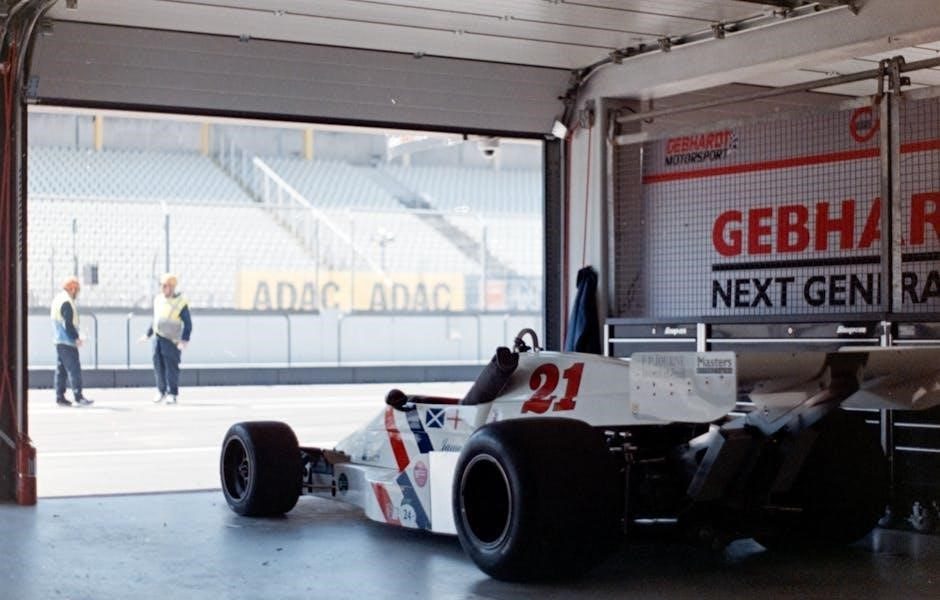
guide track
A guide track serves as a reference or template for aligning audio and video elements, ensuring synchronization and coherence in music production and post-production workflows.
1.1 What is a Guide Track?
A guide track is a reference audio or MIDI file used to synchronize and align other elements in music production and post-production. It provides a foundational template for timing, melody, and rhythm, ensuring consistency across tracks. Often recorded during pre-production, guide tracks help artists and producers maintain musical accuracy. They are widely used in video editing, live performances, and collaborative projects to ensure all elements stay in sync. Guide tracks can be simple melodies or full arrangements, offering flexibility for creators to build upon while maintaining a cohesive structure.
1.2 Importance of Guide Tracks in Music Production
Guide tracks are essential for maintaining consistency and accuracy in music production. They serve as a reference point for timing, melody, and tempo, ensuring all elements align perfectly. By providing a clear structural foundation, guide tracks simplify the recording and editing process. They are particularly valuable in collaborative projects, allowing multiple artists to stay in sync. Additionally, guide tracks help in organizing sessions and achieving the desired sound efficiently. Their use enhances creativity by offering a reliable framework, making them indispensable in both studio and post-production environments for ensuring high-quality, cohesive results.
1.3 Brief History of Guide Tracks in Audio Production
The concept of guide tracks originated in early audio production, evolving alongside recording technology. In the analog era, guide tracks were often simple click tracks or reference vocals to help artists stay in sync. With the advent of digital audio workstations (DAWs) in the 1990s, guide tracks became more sophisticated, incorporating MIDI and tempo maps. Modern guide tracks now integrate advanced features like timecode syncing and automation, enabling precise alignment and enhancing collaboration. This evolution reflects the growing need for efficiency and accuracy in music production, making guide tracks a cornerstone of contemporary audio workflows.

Creating a Guide Track
Creating a guide track involves setting up your DAW, selecting appropriate instruments or vocals, and recording a reference for tempo and timing to guide production.
2.1 Setting Up Your DAW for Guide Track Recording
Setting up your DAW for guide track recording involves organizing tracks by function, using roles to categorize clips, and arranging sessions for clear workflow. Import audio files, create a multitrack session, and ensure proper levels for recording. Use the metronome for consistent tempo and enable click tracks if needed. Label tracks clearly and group related elements to maintain organization. Set up proper routing for inputs and outputs, ensuring a clean signal path. Adjust buffer sizes for low latency and test recording levels before capturing. This setup ensures a smooth and efficient guide track recording process.
2.2 Choosing the Right Equipment for Recording
Selecting appropriate equipment is crucial for high-quality guide track recording. Use a reliable microphone suited to your recording environment, such as a condenser for detailed capture or a dynamic for live settings. Pair it with a sturdy audio interface offering clean preamps and low noise. Invest in good-quality studio monitors or headphones for accurate sound representation. Ensure cables are durable and free from interference. Choose a pop filter to reduce plosives and an acoustic-treated space to minimize echo and external noise. This setup ensures clarity and professionalism in your guide track recordings.
2.3 Best Practices for Recording a Guide Track
Record in a quiet environment to minimize background noise. Use a metronome if tempo consistency is critical. Set levels appropriately to avoid distortion. Perform with energy and intention, as this sets the foundation for the final track. Capture multiple takes to provide options during editing. Communicate clearly with collaborators about the vision and structure. Keep the guide track simple, focusing on key elements like melody, rhythm, or chords. Avoid overproducing, as the guide track is a reference, not the final product. Ensure the recording is clear and well-organized for easy synchronization later.

Editing a Guide Track
Editing a guide track involves refining the recording by trimming, aligning, and enhancing clarity. This step ensures the track accurately represents the desired final product, maintaining its intent and quality for further production.
3.1 Basic Audio Editing Techniques for Guide Tracks
Basic audio editing techniques for guide tracks include cutting, copying, and pasting audio regions to arrange and refine the structure; Time alignment ensures synchronization with visual elements, while noise reduction and EQ adjustments enhance clarity. Volume automation and leveling balance the track’s dynamics. These foundational steps ensure the guide track is polished and accurately represents the intended production, providing a clear reference for further creativity and collaboration.
3.2 Trimming and Splitting Audio Regions
Trimming and splitting audio regions are essential for refining guide tracks. Trimming removes unwanted parts at the start or end of a clip, ensuring only the desired audio remains.
Splitting allows dividing a region into smaller sections for precise adjustments, such as aligning beats or correcting timing errors.
These edits enable better synchronization with visual elements and enhance the overall flow of the track.
By isolating specific parts, you can fine-tune dynamics and ensure the guide track accurately represents the intended production, making it easier for collaborators to follow and build upon.
3.3 Pitch Correction and Timing Adjustments
Pitch correction ensures notes in a guide track are in tune, enhancing clarity and professionalism.
Tools like Melodyne or Auto-Tune are commonly used to fix off-key sections.
Timing adjustments align audio with the project’s tempo, correcting delays or rushes.
These edits maintain a consistent rhythm, crucial for synchronization with visuals or instruments.
By refining pitch and timing, the guide track becomes a precise reference, aiding collaborators in achieving a polished final product.
Overcorrection should be avoided to preserve the track’s natural feel and emotional authenticity.

Mixing and Enhancing Guide Tracks
Mixing involves EQing and compressing guide tracks for clarity and consistency, while effects like reverb or delay enhance depth and emotion, balancing levels for optimal sound quality.
4.1 EQing and Compression for Clarity
EQing and compression are essential for enhancing the clarity of guide tracks. EQing involves boosting or cutting specific frequencies to ensure elements like vocals or instruments stand out. High-pass filters can remove unwanted low-end rumble, while boosting high frequencies adds brightness and definition. Compression evens out dynamics, controlling peaks and ensuring consistent levels. A moderate compression ratio (4:1 to 6:1) with a threshold set to tame loud sections works well. These techniques help maintain balance and ensure the guide track sits well within the mix, providing a clear reference for other elements during production.
4.2 Adding Effects to Enhance the Track
Adding effects to a guide track can significantly enhance its quality and usability. Reverb and delay effects create depth and space, making the track more engaging. Stereo imaging tools help widen the soundstage, improving clarity. Saturation or subtle distortion can add warmth and character. Additionally, using automation on effects like filters or panning can create dynamic interest. However, effects should be used sparingly to avoid overwhelming the track. The goal is to enhance the guide track without complicating its primary purpose as a reference for other elements in the production. This ensures it remains clear and effective for collaborators.
4.3 Balancing Levels for Optimal Sound
Balancing levels is crucial for achieving a polished and professional guide track. Proper leveling ensures that all elements are audible and well-integrated, preventing overpowering frequencies or overly quiet sections. Use your DAW’s metering tools to monitor peak levels, aiming for a balanced mix that avoids clipping; Adjust individual tracks to create a cohesive sound, ensuring vocals, instruments, and effects are in harmony. Automation can be used to fine-tune dynamics in specific sections, maintaining consistency across the track. This step ensures the guide track is clear, well-balanced, and ready for further collaboration or post-production processes.

Synchronizing Guide Tracks
Synchronizing guide tracks involves aligning audio with visual elements using timecode, ensuring precise timing and coherence between sound and image for seamless playback in production environments.
5.1 Using Timecode for Syncing Audio and Video
Timecode is a crucial tool for synchronizing audio and video, providing a shared timeline reference. By embedding timecode in both audio and video files, editors can ensure precise alignment during post-production. This method is especially vital in professional settings where accuracy is paramount. Timecode allows for seamless integration of guide tracks with visual elements, ensuring that music, dialogue, and sound effects are perfectly timed. Modern DAWs and video editing software support timecode synchronization, making the process efficient and reliable for creators.
5.2 Aligning Guide Tracks with Visual Elements
Aligning guide tracks with visual elements ensures a seamless integration of audio and video. Editors often adjust audio cues to match on-screen actions, enhancing storytelling and immersion. Techniques like cutting shots to beats and syncing music swells with emotional peaks are common. Timecode is frequently used to lock guide tracks to specific visual moments, maintaining synchronization. This process is critical in post-production, where precision ensures a cohesive final product. By aligning guide tracks with visual elements, creators can effectively enhance the overall narrative and emotional impact of their work.
5.3 Exporting Guide Tracks for Collaboration
Exporting guide tracks is essential for collaboration, allowing team members to work on different aspects of a project. It’s crucial to export in a compatible format, such as WAV or MP3, ensuring clarity and quality. Include metadata like tempo, timecode, and track labels for easy reference. Use standardized filenames and organize files in clearly labeled folders. For video syncing, export guide tracks with embedded timecode or as an AAF file for seamless integration. This ensures all collaborators are aligned, streamlining the production process and maintaining consistency across the project.
Organizing Guide Tracks in Projects
Organizing guide tracks involves creating a clear structure with named folders, consistent labeling, and categorizing tracks by type. Use color-coding or grouping in your DAW for easy navigation and efficient collaboration, ensuring all elements are neatly arranged and accessible throughout the production process.
6.1 Naming Conventions for Guide Tracks
Establishing clear naming conventions for guide tracks is essential for maintaining organization and clarity in music production projects. Use descriptive labels that indicate the track’s purpose, such as “VocalGuide” or “DrumReference.” Include details like the date or version number, e.g., “VocalGuide_20231025_v1,” to track updates. Avoid generic names like “Track1” or “Untitled,” as they can lead to confusion. Instead, adopt a consistent format that reflects the track’s function and project phase. This ensures easy identification and efficient collaboration, especially when working with multiple guide tracks or sharing files with team members. Consistency is key to avoiding errors and streamlining workflows.
6.2 Color-Coding and Track Grouping
Color-coding and track grouping are effective strategies for organizing guide tracks within a project. Assign distinct colors to different types of guide tracks, such as blue for vocals or green for instrumental references, to enhance visual differentiation. Group related tracks into folders or busses, like “VocalGuides” or “DrumReferences,” to simplify navigation. This method ensures quick access and reduces clutter in your workspace. Additionally, using labels or tags can further categorize tracks, making it easier to locate specific elements during editing or mixing. These practices improve workflow efficiency and maintain a tidy project structure, which is crucial for collaborative environments.
6.3 Managing Multiple Guide Tracks in a Session
Managing multiple guide tracks in a session requires organization and clear strategies to maintain efficiency. Use track templates for consistent setup and labeling to ensure easy identification. Group related guide tracks into folders or busses, such as “VocalGuides” or “InstrumentalReferences,” to streamline navigation. Utilize automation to control levels or mute inactive tracks dynamically. Regularly backup and export guide tracks as stems for collaboration. This approach ensures clarity, reduces clutter, and enhances workflow, especially in complex projects with numerous elements. Proper management fosters creativity and professionalism, making the production process smoother and more productive.

Best Practices for Using Guide Tracks
Use guide tracks to maintain consistency and clarity in your production. Ensure they are precise and updated regularly to enhance workflow and collaboration.
7.1 When to Use Guide Tracks in Music Production
Guide tracks are invaluable during the early stages of music production for setting the foundation and maintaining consistency. Use them to establish tempo, timecode, and arrangement structure. They are particularly useful for syncing audio elements like drums, basslines, and vocals. Guide tracks also help when recording overdubs, ensuring alignment with the main arrangement. Additionally, they are essential for collaboration, providing a clear reference for other artists or mix engineers. Use guide tracks during pre-production to experiment with arrangements and during post-production to sync audio with visual elements seamlessly. They are a versatile tool for keeping your production organized and cohesive from start to finish.
7.2 Common Mistakes to Avoid When Creating Guide Tracks
When creating guide tracks, avoid common pitfalls that can disrupt your workflow. One major mistake is improper synchronization, leading to misaligned audio and video elements. Neglecting to set the correct tempo or timecode can cause timing issues. Poor audio quality in guide tracks can also affect the final production. Additionally, failing to label tracks clearly can lead to confusion, especially in collaborative projects. Overcomplicating the guide track with too many elements can distract from its purpose. Finally, not exporting guide tracks in the correct format for sharing can hinder collaboration. Addressing these errors ensures a smoother production process.
7.3 Tips for Effective Communication with Collaborators
Effective communication is crucial when working with collaborators on guide tracks. Clearly label and organize tracks to avoid confusion. Use consistent naming conventions and provide context for each track’s purpose. Regularly share updates and seek feedback to ensure alignment. Utilize project management tools to track progress and assign tasks. Maintain open lines of communication through comments or notes within your DAW. Be patient and open to suggestions, as collaboration thrives on diverse perspectives. By fostering clear and respectful communication, you can ensure a smooth workflow and a successful outcome for your project.
Advanced Techniques for Guide Tracks
Explore MIDI sequencing, loop integration, and automation to create dynamic guide tracks. These techniques enhance precision and flexibility in music production and post-production workflows.
8.1 Using MIDI for Creating Guide Tracks
MIDI offers a powerful way to create precise and flexible guide tracks. By using MIDI sequences, producers can program rhythms, melodies, and harmonies without audio limitations. This allows for easy editing and adjustments, making it ideal for aligning visual elements in post-production. MIDI guide tracks can be exported and synced with video, ensuring accurate timing. Additionally, MIDI’s non-destructive nature enables experimentation with different sounds and arrangements, enhancing creativity and efficiency in the production process.
8.2 Incorporating Loops and Samples as Guide Tracks
Loops and samples can serve as effective guide tracks, providing a foundational structure for a project. They offer consistent timing and tone, aiding in maintaining the desired feel. By incorporating pre-recorded elements, producers can quickly establish a rhythm or melody, saving time and inspiring creativity. Loops and samples also allow for easy experimentation, enabling adjustments in tempo, pitch, and arrangement. This approach is particularly useful in post-production, where syncing audio with visual elements is crucial. However, it’s important to ensure proper clearance of rights for any copyrighted material used in guide tracks to avoid legal issues. This method streamlines the production process and enhances overall workflow efficiency.
8.3 Automating Levels and Effects for Dynamic Guide Tracks
Automating levels and effects in guide tracks enhances their dynamic nature, allowing for real-time adjustments that match the project’s evolving needs. By programming volume, pan, and effects like reverb or delay, guide tracks become more engaging and contextually relevant. This technique is especially valuable in post-production, where syncing audio with visual elements requires precision. Automation ensures that guide tracks adapt seamlessly to the overall mix, maintaining balance and clarity. Producers can achieve professional-grade guide tracks by leveraging these tools, ultimately elevating the production’s quality and emotional impact.

Guide Tracks in Post-Production
Guide tracks play a crucial role in post-production, aiding synchronization of audio with video, and organizing elements like dialogue, SFX, and music for a cohesive mix.
9.1 Role of Guide Tracks in Video Editing
Guide tracks are essential in video editing for synchronizing audio-visual elements. They help editors align dialogue, music, and sound effects with visuals, ensuring precise timing and emotional impact. By providing a clear reference, guide tracks streamline the editing process, allowing for seamless integration of all components. They also assist in creating a cohesive narrative by matching visual cuts to musical beats or dialogue cues. This synchronization enhances storytelling and maintains viewer engagement. Guide tracks thereby play a vital role in achieving a polished and professional final product in post-production workflows.
9.2 Syncing Guide Tracks with Dialogue and SFX
Syncing guide tracks with dialogue and sound effects (SFX) ensures precise alignment between audio elements and visual content. Editors use timecode to match dialogue and SFX to specific video frames, creating a cohesive experience. Guide tracks act as a reference, helping maintain consistency in timing and placement. This synchronization is crucial for dialogue to naturally complement on-screen actions and for SFX to enhance visual elements. Proper syncing enhances storytelling, making scenes more immersive and engaging. Advanced tools and software features further streamline this process, ensuring accuracy and efficiency in post-production workflows.
9.3 Delivering Guide Tracks for Final Mixing
Delivering guide tracks for final mixing involves organizing and exporting audio elements to ensure seamless integration with the mixer’s workflow. Guide tracks are typically provided as high-quality stems or consolidated files, labeled clearly for easy identification. It’s essential to include detailed notes on levels, panning, and timing preferences. Properly formatted files and clear communication help mix engineers achieve the desired balance and tone. Exporting guide tracks in industry-standard formats ensures compatibility across various mixing platforms. This step is critical for maintaining artistic intent and achieving professional results in the final mix;
Guide tracks are essential tools in music and post-production, ensuring synchronization and coherence. Their proper creation, editing, and delivery streamline workflows, enhancing final outputs and artistic visions effectively.
10.1 Recap of Key Takeaways
Guide tracks are indispensable in music and post-production, ensuring synchronization and coherence. They streamline workflows by providing a reference for aligning audio and video elements. Proper creation, editing, and delivery of guide tracks enhance final outputs. Key takeaways include their role in organizing projects, facilitating collaboration, and saving time. Best practices involve clear communication with collaborators and adhering to naming conventions. Guide tracks are versatile, aiding in both music production and post-production tasks. By leveraging these tools effectively, creators can achieve polished and professional results, making guide tracks an essential component of modern audiovisual workflows.
10.2 Future Trends in Guide Track Usage
Future trends in guide track usage will likely involve enhanced integration with AI tools for automated synchronization and smarter editing. Cloud-based collaboration will streamline sharing and syncing guide tracks across teams. Advances in immersive audio formats, like 3D audio, will require more precise guide track alignment. Additionally, real-time tracking and adaptive tempo matching could become standard features. These innovations will make guide tracks even more essential for efficient and high-quality music and post-production workflows, ensuring they remain a cornerstone of creative projects.
Related Posts

san diego tour guide
Discover San Diego’s hidden gems, local favorites, and top attractions with our expert tour guide. Plan your perfect trip today!

guide to lava lamps
Discover the hypnotic beauty of lava lamps. Explore their history, designs, and how they can elevate your home decor with a retro vibe.

k-swap guide pdf
Discover the ultimate K-swap guide PDF! Learn easy installation, expert tips, and boost your engine’s performance. Download now!